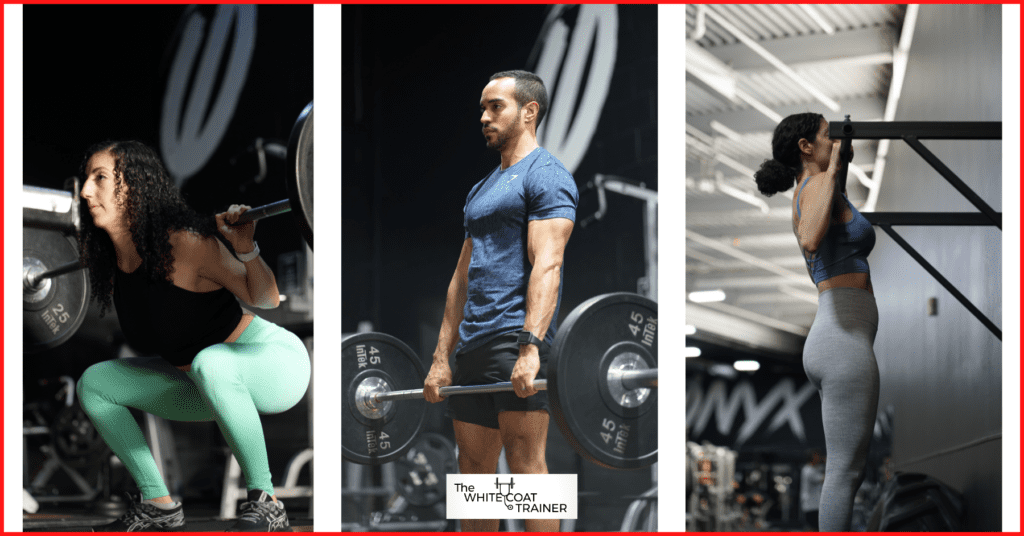Can you gain muscle while cutting or losing fat?
The answer is yes, but it’s not easy, and you won’t be able to build a lot of muscle while in a calorie deficit.
Building muscle while cutting (aka body recomposition) is ideal for a handful of people who meet specific criteria.
Keep reading to learn more.

Can I Build Muscle When Cutting?
The answer is yes.
It is possible to build a small amount of muscle while in a calorie deficit, but it isn’t going to be as much as if you were in a caloric surplus.
When you are in a caloric deficit, your body does not have the same amount of energy available to build new muscle tissue.
If you think about it, the two processes (building muscle and burning fat) are antagonistic.
That said, it is possible to do it.
You just have to know what you are doing!
How To Cut Body Fat And Gain Muscle At The Same Time
There are five things you need to do to build muscle while cutting.
Maintain a Small Calorie Deficit
The first thing you need to pay attention to is your nutrition and calorie intake. To lose body fat, you need to make sure that you are in a caloric deficit.
In other words, you need to consume fewer calories than your body needs to maintain its current weight.
However, it would be best if you did not create a significant cut in your caloric intake. A large calorie deficit can cause your body to burn fat AND extra muscle for energy.
To prevent this, start with a small calorie deficit.
A good place to start is with a 10% reduction in calories and monitor your progress in 1-2 weeks.
If you are already lean, you might be able to achieve body recomposition with maintenance calories.
Increase Protein Consumption
The second thing you need to do is eat enough protein. Protein is the building block of muscle tissue and is essential for muscle growth.
Studies show that high protein intake during periods of weight loss not only helps build but can help preserve muscle mass.
As such, it is essential to increase your protein intake when cutting.
During a cut, try to get as close to 1 gram of protein per pound of body weight.
So, if you weigh 200 pounds, you should eat ~200 grams of protein daily.
| Best Sources of Protein |
|---|
| Lean chicken breast |
| Salmon |
| Lean beef |
| Greek yogurt |
| Legumes (chickpeas, lentils, black beans) |
| Tofu |
| Tempeh |
| Edamame |
| Seeds (hemp seeds) |
| Quinoa |
| Protein powder supplements |
Use Compound Exercises
The third and most important thing you must do is regular resistance training.
Specifically, you should focus on compound exercises as these movements can help you target every major muscle group in the body with a few exercises.
Some examples of compound exercises that target the major muscle groups are:
- squats,
- deadlifts,
- pull-ups, and
- bench press.
- rows
Doing these exercises regularly helps to build overall strength and signal to your body that it needs to preserve muscle tissue.
You might also benefit from keeping your workouts relatively short but intense. Quality over quantity is probably best when trying to build muscle in a deficit.
I go over the best way to create a highly effective strength training program here in just 30 minutes a day.

Use Progressive Overload When Possible
The fourth thing you can try to do is progressive overload. In other words, try to gradually increase the weight, volume, or intensity of your workouts over time.
As you get stronger, your muscles need to be challenged with more stimuli to continue adapting.
With that said, it might not be possible to always make progress while you are in a caloric deficit.
Just do your best to push yourself and challenge your muscles constantly.
I go over ten ways to overload progressively in this post.
Get Enough Sleep
Last but not least, make sure you are getting enough sleep. Sleep is when your body recovers from exercise and builds new muscle tissue.
If you aren’t sleeping enough, your body won’t have the energy or resources to recover and grow.
Most people need 7-9 hours of sleep per night to recover adequately from intense workouts.
Training hard while in a deficit, while not getting enough sleep, is a recipe for disaster.
Who Benefits The Most From Building Muscle While Cutting?
Now that we know it’s possible to build muscle while in a deficit let’s talk about who may benefit from this approach.
Generally speaking, there are three types of people who may benefit the most from building muscle while cutting:
People who are new to lifting weights
If you are new to lifting weights, your body will be much more responsive to muscle-building stimuli.
Beginners can build muscle while cutting since the energy released from fat oxidation may be used to fuel muscular growth.
During this time, your body is highly efficient at building muscle and strength, even in a calorie deficit.
Someone who has a lot of fat to lose
Your body composition matters. If you carry a lot of body fat, you have a higher margin for error when cutting calories.
You can afford to be in a slightly larger calorie deficit without sacrificing too much muscle mass, as there is excess fat to pull energy from.
Thus, it may be easier for someone who is obese to build muscle while cutting than someone leaner.
Someone who hasn’t trained in a while or has been training sub-optimally
If you have taken a long break from lifting weights or have been training sub-optimally, your body is going to be much more responsive to muscle-building stimuli.
This means that you will be able to build muscle while cutting calories much more quickly than someone who has been lifting weights consistently and optimally for years.
Other Related Questions
Can You Gain Muscle While Maintaining Weight?
Yes, it is possible to gain muscle while maintaining weight. In essence, gaining muscle while maintaining weight is the same as a body recomposition.
A body recomposition is when you lose fat and gain muscle simultaneously. As a result, the net change in your weight is zero.
How Do I Lose Fat And Gain Muscle At The Same Time As A Female?
It is possible to lose fat and gain muscle simultaneously, though it may require more effort for females than males.
Women generally have a higher body fat percentage than men, as they store more fat in the hips and thighs. In addition, women tend to have less muscle mass than men and a slower metabolism.
As a result, it can be difficult for women to lose fat and gain muscle simultaneously.
To help offset this, females need to exercise more deliberately than men, as they have a smaller margin for error.
Specifically, females should decrease cardio and increase weight training sessions to keep the muscle-building stimulus high.
In addition, females must ensure they are eating enough calories and protein to support their fitness goals.
Should I Bulk Or Cut First?
If you decide to split your training into two distinct phases, bulking (aka muscle and fat gain) and cutting (losing fat without losing muscle), the order in which you do them will depend on your starting point.
If you are relatively lean (~15% body fat for men, ~20% for women), you may want to consider bulking first.
If you are carrying a lot of body fat (>20% for men, >25% for women), you may want to consider a cutting phase first.
Regardless of your approach, be sure to focus on eating healthy foods and getting enough protein.
Conclusion
Yes, you can gain muscle while cutting. However, it may be more complicated than if you were maintaining your weight, trying to lose fat, or trying to gain muscle individually.
Regardless, focus on eating a healthy diet and getting enough protein. Lastly, train regularly to support your fat loss and muscle-building goals.
Now I want to hear from you.
Have you ever tried to gain muscle while cutting?
How did it go?
Let me know in the comments below.
Related Articles:
- How To Prevent Muscle Loss When Losing Fat
- A Tried and Tested Strength Training Program For Busy Professionals
- How To Diet Without Worrying About The Number of Calories You Are Consuming

Alex Robles, MD, CPT / Brittany Robles, MD, MPH, CPT
Alex & Brittany Robles are physicians, NASM Certified Personal Trainers, and founders of The White Coat Trainer: a resource dedicated to improving the health and fitness of busy professionals using time-efficient strategies. Their advice has been featured in My Fitness Pal, Prevention, Livestrong, Reader’s Digest, Bustle, The Active Times, and more. Learn more about them here.
References:
- Pasiakos SM, Cao JJ, Margolis LM, Sauter ER, Whigham LD, McClung JP, Rood JC, Carbone JW, Combs GF Jr, Young AJ. Effects of high-protein diets on fat-free mass and muscle protein synthesis following weight loss: a randomized controlled trial. FASEB J. 2013 Sep;27(9):3837-47. doi: 10.1096/fj.13-230227. Epub 2013 Jun 5. PMID: 23739654.
- Bredella MA. Sex Differences in Body Composition. Adv Exp Med Biol. 2017;1043:9-27. doi: 10.1007/978-3-319-70178-3_2. PMID: 29224088.
- Paoli A, Gentil P, Moro T, Marcolin G, Bianco A. Resistance Training with Single vs. Multi-joint Exercises at Equal Total Load Volume: Effects on Body Composition, Cardiorespiratory Fitness, and Muscle Strength. Front Physiol. 2017 Dec 22;8:1105. doi: 10.3389/fphys.2017.01105. PMID: 29312007; PMCID: PMC5744434.
